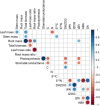Limited efficacy of a commercial microbial inoculant for improving growth and physiological performance of native plant species
- PMID: 38894755
- PMCID: PMC11184453
- DOI: 10.1093/conphys/coae037
Limited efficacy of a commercial microbial inoculant for improving growth and physiological performance of native plant species
Abstract
Soil microbial inoculants are increasingly being explored as means to improve soil conditions to facilitate ecological restoration. In southwestern Western Australia, highly biodiverse Banksia woodland plant communities are increasingly threatened by various factors including climate change, land development and mining. Banksia woodland restoration is necessary to conserve this plant community. The use of microbial inoculation in Banksia woodland restoration has not yet been investigated. Here, we evaluated the efficacy of a commercial microbial inoculant (GOGO Juice, Neutrog Australia Pty Ltd) for improving the performance of 10 ecologically diverse Banksia woodland plant species in a pot experiment. Plants were subjected to one of two watering regimes (well-watered and drought) in combination with microbial inoculation treatments (non-inoculated and inoculated). Plants were maintained under these two watering treatments for 10 weeks, at which point plants in all treatments were subjected to a final drought period lasting 8 weeks. Plant performance was evaluated by plant biomass and allocation, gas exchange parameters, foliar carbon and nitrogen and stable isotope (δ15N and δ13C) compositions. Plant xylem sap phytohormones were analysed to investigate the effect of microbial inoculation on plant phytohormone profiles and potential relationships with other observed physiological parameters. Across all investigated plant species, inoculation treatments had small effects on plant growth. Further analysis within each species revealed that inoculation treatments did not result in significant biomass gain under well-watered or drought-stressed conditions, and effects on nitrogen nutrition and photosynthesis were variable and minimal. This suggests that the selected commercial microbial inoculant had limited benefits for the tested plant species. Further investigations on the compatibility between the microorganisms (present in the inoculant) and plants, timing of inoculation, viability of the microorganisms and concentration(s) required to achieve effectiveness, under controlled conditions, and field trials are required to test the feasibility and efficacy in actual restoration environments.
Keywords: Banksia woodlands; microbial inoculation; mine site restoration; phytohormones; xylem sap.
© The Author(s) 2024. Published by Oxford University Press and the Society for Experimental Biology.
Conflict of interest statement
The authors report no conflict of interest.
Figures





Similar articles
-
Plant and Native Microorganisms Amplify the Positive Effects of Microbial Inoculant.Microorganisms. 2023 Feb 24;11(3):570. doi: 10.3390/microorganisms11030570. Microorganisms. 2023. PMID: 36985145 Free PMC article.
-
Inoculation of plant growth-promoting bacteria attenuates the negative effects of drought on sorghum.Arch Microbiol. 2020 Jul;202(5):1015-1024. doi: 10.1007/s00203-020-01810-5. Epub 2020 Jan 13. Arch Microbiol. 2020. PMID: 31932864
-
Microbial Drivers of Plant Performance during Drought Depend upon Community Composition and the Greater Soil Environment.Microbiol Spectr. 2023 Mar 21;11(2):e0147622. doi: 10.1128/spectrum.01476-22. Online ahead of print. Microbiol Spectr. 2023. PMID: 36943043 Free PMC article.
-
Azospirillum and arbuscular mycorrhizal colonization enhance rice growth and physiological traits under well-watered and drought conditions.J Plant Physiol. 2011 Jul 1;168(10):1031-7. doi: 10.1016/j.jplph.2010.12.019. Epub 2011 Mar 5. J Plant Physiol. 2011. PMID: 21377754
-
Microbial inoculation of seed for improved crop performance: issues and opportunities.Appl Microbiol Biotechnol. 2016 Jul;100(13):5729-46. doi: 10.1007/s00253-016-7590-9. Epub 2016 May 17. Appl Microbiol Biotechnol. 2016. PMID: 27188775 Free PMC article. Review.
Cited by
-
Effects of environmental factors on the phenotypic traits and seed element accumulation of wild Elymus nutans in Tibet.Sci Rep. 2025 Jan 13;15(1):1838. doi: 10.1038/s41598-025-85415-2. Sci Rep. 2025. PMID: 39805884 Free PMC article.
-
Microbial Inoculants in Sustainable Agriculture: Advancements, Challenges, and Future Directions.Plants (Basel). 2025 Jan 11;14(2):191. doi: 10.3390/plants14020191. Plants (Basel). 2025. PMID: 39861545 Free PMC article. Review.
-
Vulnerability of soil food webs to chemical pollution and climate change.Nat Ecol Evol. 2025 Jul;9(7):1112-1119. doi: 10.1038/s41559-025-02736-1. Epub 2025 Jun 17. Nat Ecol Evol. 2025. PMID: 40527932 Review.
-
Guiding plant conservation using physiological tools: how mechanistic research can bridge disciplinary divides.Conserv Physiol. 2025 Jan 9;13(1):coae090. doi: 10.1093/conphys/coae090. eCollection 2025. Conserv Physiol. 2025. PMID: 39803326 Free PMC article. No abstract available.
References
-
- Ambrosini A, Souza R, Passaglia LMP (2016) Ecological role of bacterial inoculants and their potential impact on soil microbial diversity. Plant and Soil 400: 193–207. 10.1007/s11104-015-2727-7. - DOI
-
- Badenoch-Jones J, Parker CW, Letham DS, Singh S (1996) Effect of cytokinins supplied via the xylem at multiples of endogenous concentrations on transpiration and senescence in derooted seedlings of oat and wheat. Plant Cell Environ 19: 504–516. 10.1111/j.1365-3040.1996.tb00384.x. - DOI
LinkOut - more resources
Full Text Sources
Miscellaneous

